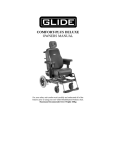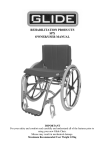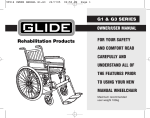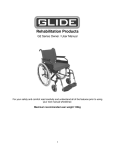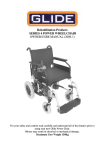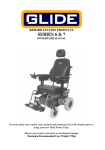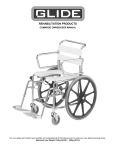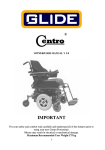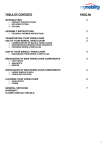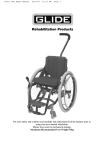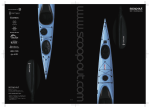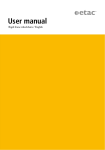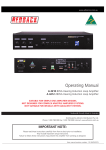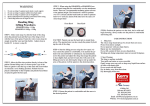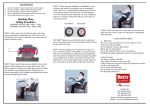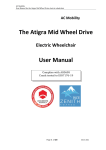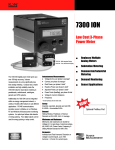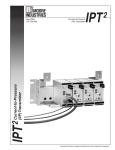Download TS TILT CHAIR - Glide Rehabilitation Products
Transcript
REHABILITATION PRODUCTS TS TILT CHAIR OWNER/USER MANUAL For your safety and comfort read carefully and understand all of the features prior to using your new Glide Products chair. Maximum Recommended User Weight 100kg TABLE OF CONTENTS SECTION 1. INTRODUCTION SECTION 2. STANDARD FEATURES SECTION 3. OPERATING YOUR WHEELCHAIR SECTION 4. TRANSPORTING YOUR CHAIR SECTION 5. ROUTINE MAINTENANCE SECTION 6. ENVIRONMENT PRECAUTIONS SECTION 7. TRANSFERRING TO AND FROM YOUR WHEELCHAIR SECTION 8. AVAILABLE OPTIONS SECTION 9. SPARE PARTS SECTION 10. WARRANTY 2 SECTION 1. INTRODUCTION Thank you for choosing the Glide TS Tilt Wheelchair. An Australian designed and manufactured product and has a manufacturers recommended user weight of 100kg. The chair passes AS3695 and EN 12183 standards for 100kg With proper care and operation your wheelchair will provide years of trouble free mobility. Please take the time to familiarise yourself with the functions and features of your chair by reading this owners manual. If you have any queries about the functions of the chair you can call Glide Rehabilitation Products or your nearest Glide Rehabilitation Products dealer. GLIDE PRODUCTS 25 LEDGAR RD BALCATTA PERTH. WA. 6021 AUSTRALIA PH +61 8 9345 3400 FAX +61 8 9345 1384 BVQI logo in here 3 SECTION 2. STANDARD FEATURES The illustration (Fig 1. below) is a list of standard features on your TS Tilt Seat wheelchair. 1. 12” Rear Wheels 2. 7” MCP front castor wheels 3. Vinyl Seat & Back Upholstery for easy care 4. Hand Operated Attendant Brakes 5. Swing Away Legrests 6. Non - Adjustable Armrests 7. Push Handle 8. Hand Operated Gas Seat Tilt Adjustment 9. Backrest Extension 9. 7. 3. 8. 6. 5. 4. 1. 2. 10. 4 Figure 1. SECTION 3. OPERATING YOUR WHEELCHAIR ARMRESTS Standard armrests are non adjustable in height and removable FOOTRESTS The footrests are swing away and detachable. They swing out by either pushing or pulling the release lever. The type of release lever fitted to your chair depends on your ability and footplate type fitted to your chair. When lever is released the footplate will simply swing out and lift off the two locating pins. When refitting footrest to chair ensure that it is located on both locating pins. Damage may result if only one pin is used. HEIGHT ADJUSTMENT OF FOOTPLATE Your footplate will be fitted with one of two types of adjustment styles. 1. Standard Footplate with Incremental Hole Type – to adjust height simply un do and remove bolt, move footplate to nearest hole to suit desired height, replace and tighten bolt firmly 2. Optional Elevating Legrest – to adjust simply loosen 5 point turn wheel, move to desired position, re-tighten 5 point turn wheel firmly. 5 BRAKES The TS Tilt Seat wheelchair has as standard, hand operated manual attendant brakes. To apply brakes simply push brake lever forward until it stops. To release, pull lever back. Ensure brake is fully retracted. TYRES The TS Tilt Seat wheelchair comes standard with 12 ½” x 2 ¼ “ pneumatic rear tyres and 7” MCP (solid) front castors. Rear tyres need to be inflated to 35 psi. 7” pneumatic front castors (optional) 30psiPneumatic tyres should be kept at correct inflation. Under inflated tyres will make it difficult to push and steer. 6 ADJUSTING THE SEAT ANGLE (TILT) The TS Tilt Seat has as standard, a hand activated, Gas Operated Tilt function. To adjust, simply pull up on hand lever, push down on rear push handle to move to desired position, release hand lever. This will lock seat in position 7 SECTION 4. TRANSPORTING YOUR CHAIR TRANSPORTING IN A SPECIAL WHEELCHAIR TAXI, BUS OR PRIVATE VEHICLE WHILE THE USER IS IN CHAIR. To date there is no recognized Australian Standard that covers wheelchairs suitable for vehicle transport while the user is in the chair. However Glide Products have determined suitable tie-down location points and restraint system (Unwin 4 point) for your chair when being transported. Where possible, wheelchair occupants should be transferred into and use the proper vehicle seat and restraints. However, if your chair is to be transported in a vehicle, your vehicle restraint system must comply with AS2942 – 1994. CAUTION : Do not use legrests or footplates as attachment points for your tie down system. Do not use armrests as attachment points for your tie down system. Unoccupied wheelchairs in vehicles must be safely secured or stored securely outside the passenger compartment. Posture Positioning Belts should not be used as vehicle restraint belts. NOTE: Ensure that your restraint system complies with AS2942 and you fully understand the manufacturer instructions on how your tie down system works and whether it is compatible with the Glide TS Tilt Seat Chair. 8 SECTION 5. ROUTINE MAINTENANCE WEEKLY 1. Check tyre pressures 35PSI rear 2. Clean frame and vinyl parts with mild soapy solution. 3. Wipe upholstery with a clean damp cloth 4. Check function of brakes 5. Check all cables and connectors are secured (Tilt Mechanism) MONTHLY 1. Give the chair a general inspection for loose nuts and bolts. 2. Inspect and clean upholstery, functionality of Gas Operated Tilt mechanism 3. Check for correct adjustment (contact) of brakes on tyres. When tyres are correctly inflated the brake contact lever should depress tyre by 1cm. If they require adjustment, simply loosen brake clamp bolts & make adjustment, retighten bolts firmly For any questions concerning procedures or service, contact your nearest Glide Products Agent or Glide Products direct. ANNUALLY We recommend that your wheelchair, be serviced by an approved Glide Rehabilitation Products Agent at least once a year. 9 SECTION 6. ENVIRONMENT PRECAUTIONS The Glide Rehabilitation Products TS Tilt Wheel Chair has been designed with the user safety as it’s prime consideration. Even though the TS Tilt Wheelchair has been designed with safety as it’s prime consideration, this does not negate the effect or take into account, circumstances, which put the wheelchair outside the specified operating conditions for which it was designed. It is important that the user takes due care and understands the limitations within the environment that the chair will be operated. As a guide only, the following is a brief list of scenarios that could have an impact on occupant safety. • When attendant is pushing chair, ensure that chair is slightly tilted, this will help keep occupant positioned in seat. • When leaving occupant unattended, ensure that Hand Operated Attendant Brakes are applied. • When parking chair on an incline, ensure that Hand Operated Attendant Brakes are applied. • If there is a concern for occupant sliding forward out of chair, it is advised that a suitable restraining device may need to be fitted. Consult your health professional for advice on restraining device. • Take care when accessing door thresholds. Changes in floor height can stop castors and cause chair to tip. 10 SECTION 7. TRANSFERRING TO AND FROM YOUR WHEELCHAIR The Glide Rehabilitation Products TS Tilt Seat Wheel Chair is designed in such a way that transferring in and out can be done with a minimum of fuss. Please be aware that there is a point during transfer when the seat will not be underneath you. Please take the following precautions when transferring 1. Armrests can be removed allowing easy lateral movement from either side of chair or for the fitting of a patient hoist sling. 2. If occupant is ambulant, or able to do standing transfers, removing swing away footplates will allow better placement of feet when standing or conversely, closer access to seat when transferring into chair. 3. Where possible have someone assist you during the transfer. 4. You will need to learn safe transfer techniques from your health professional. 5. Always have chair as close as possible to chair that you are transferring to. 6. Ensure that the front castors are facing forward when transferring. 7. Ensure that the Gas Operated Seat Tilt is in the down position before attempting to transfer. 8. Ensure that your wheelchair brakes are applied. 11 SECTION 8. AVAILABLE OPTIONS 1. 2. 3. 4. 5. 6. Adjustable Height Armrests 7” Pneumatic Front Castor Wheels Elevating Legrests Stump Supports – refer to Glide Agent Flip Up and Fold Away Tray – refer to Glide Agent (Not Shown) Adjustable Arm Support – refer to Glide Agent 1. 6. 4. 2. 3. Fig 4 12 SECTION 9. SPARE PARTS TYRES 12 ½” x 2 ¼” Rear Transit Type 7” x 1 ¾ Front Pneumatic 7” MCP Front Castor Wheel TUBES 12 ½” x 2 ¼” Thorn Proof 7” x 1 ¾” Front CASTOR PINTLE AXLE ASSEMBLY 1. Dust Cap 2. Circlip 3. Top Nylon Bush 4. Pintle Axle 5. Bottom Bearing Housing 6. Bearing 7. Top & Bottom Castor Fork Retaining Nuts 8. Castor Fork 9. Castor Wheel 10. Bearing Spacer 11. Castor Wheel Bearings 12. Spacer Washers 13. Axle Bolt 14. Nyloc Axle Retaining Nut For service advice contact your Glide Rehabilitation Products Agent or Glide Rehabilitation Products direct. 13 SECTION 10. WARRANTY Lendal Pty Ltd (trading as Glide Rehabilitation Products) warrants the following as listed: Frame 3-year warranty Frame will be replaced within the first twelve month period. Thereafter, Glide will extend the warrant for further two years and will either replace or repair frame. Upholstery 6 month warranty This will cover against defects in materials or workmanship. Warranty does not cover against normal wear or damage. Tyres and Tubes No Warranty Spare Parts All spare parts sold will have a 6 months warranty period from date of purchase. This warranty does not extend to parts or components damaged by misuse, neglect, accident or improper installation, nor those tampered with, altered or serviced by an agency not authorised by Lendal Pty Ltd. The foregoing in lieu of all other warranties expressed, implied or statutory, Lendal Pty Ltd’s sole liability shall be to repair or replace parts of components as specified above. 1. 2. IMPORTANT Lendal Pty Ltd (LENDAL) does not warrant either expressly or impliedly the suitability of the Glide TS Tilt Seat wheelchair for the purchaser or any intended user. Purchasers and intended users are advised that advice from an appropriate registered medical practitioner should be obtained prior to using the TS Tilt Seat wheelchair. Except insofar as is prohibited by statute, Lendal shall not be responsible for damage, injury or loss of any kind to any property or person howsoever caused arising from or in connection with the Glide TS Tilt Seat wheelchair. All conditions and warranties that (but for this provision) would be implied in favour of, and all rights and remedies that (but for this provision) would be conferred upon the purchaser or other persons against Lendal arising under or as a result of the WARRANTY cont.. Trade Practices Act 1974, any other legislation or the general law are excluded and limited to the maximum extent possible and in cases where Lendal’s liability 14 cannot be completely excluded but may be limited, the liability of Lendal is limited to one of the following (at the option of Lendal) a) The replacement of the Glide TS Tilt Seat Wheelchair or the supply of an equivalent wheelchair b) The repair of the Glide TS Tilt Seat Wheelchair. c) The payment of the cost of replacing the Glide TS Tilt Seat Wheelchair or of acquiring an equivalent wheelchair d) The payment of the cost of having the Glide TS Tilt Seat wheelchair repaired Warranty could be voided if chair is not returned to Glide Rehabilitation Products or an authorized agent for service within 12 months of purchase. REHABILITATION PRODUCTS Glide Rehabilitation Products are manufactured in Australia by Lendal Pty. Ltd. (ACN 009 003 694) 25 Ledgar Rd Balcatta, Western Australia 6021 Australia Phone +61 8 9345 3400 Fax +61 8 9345 1384 Email: [email protected] Web: www.glide.com.au 15















